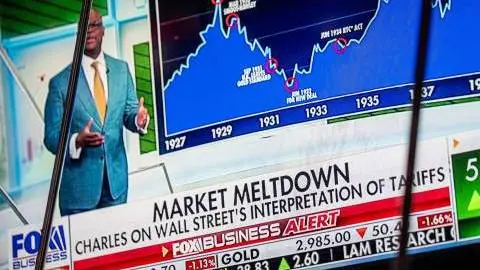Rates: US Treasuries have become a ‘pain trade’
It's been a remarkable week for US Treasuries. Rarely, if ever, have we had Treasuries being sold amid a massive fire sale of risk assets. The fact that yields have been forced higher heightens the tariff pain as there's nowhere to hide. This is where we think we are, but there are huge uncertainties ahead. It's, naturally, complicated
US Treasury yields have marched higher again – what's going on?
The impact of tariffs was the discount for a recession and more rate cuts, typically deemed a good rationale to buy bonds. It still is, and could be in months to come. But for now, we've gone the other way. Treasury bond prices have been bullied lower in the past few days, and yields have shot higher, not what would typically be expected on the build of a material recession risk.
So what's driving this? Here's how we see it.
First, the troubling notion of 'sell America Inc.' The narrative here centres on frustrated players selling Treasuries for various reasons. It's tough to get a gauge on this, and by the way, it does not have to be selling by foreigners; it can also be from domestics. Its genesis could be political (e.g. talk of selling by Chinese players), but that can quickly evolve into a relative value play where Treasuries are anticipated to fall in price, so more sellers emerge, deepening the problem.
Second, while the recession risk argues for lower market rates, other key macro factors point in the other direction. The biggest two are price rise risks coming from the tariffs, and a fear that the fiscal deficit is not being addressed. This morphs into an inflation risk and a supply pressure risk. These have been lurking in the weeds for quite some time but remain meaningful reasons for Treasury yields to test the upside.
We sent out an impact piece as the tariff story really broke from 2 April onward. It's here. We noted a bullish impulse on Treasuries on recession risks, with a 3.5% 10yr Treasury yield as perfectly possible should we enter a recessionary tendency through the second quarter. But we also noted that 'it's complicated. ' We had a prior call for 5% on the 10yr yield. We never took that off the table completely, and we've swung back in that direction as the central call, likely as a risk by the time we get to the end of the 90-day pause on the tariffs.
The deeper in the weeds market drivers – there are many to account for
We also need to incorporate background talk of (semi-forced) century bond swaps and/or a user fee (effectively an external holder tax) on Treasuries, which clearly paints a negative underpinning for holders. See more here. As we've noted before, Treasury holders don't want drama; they want simplicity, as a means to seeking haven from 'risk product' when things look bad. The last thing they want is complications. The infamous Mar-a-Lago report is one where such aforementioned complications were heralded as at least up for discussion.
As a timely market barometer, last week's US 3yr auction 'tailed' badly, by almost 2.5bp. Effectively coming at a yield concession of that size to the secondary market. The important thing about the 3yr is it’s a maturity that global central banks tend to lap up, and they tend to like short dates. There is an echo here of the aforementioned accord. Hard to say whether this was a driver, but either way, the demand was very poor for what is a classic flight-to-safety area of the curve.
Spread from 10yr SOFR (risk free rate) to the 10yr Treasury yield
The 10yr 'swap spread'

We also note that the US 10yr swap spread has shot out to 60bp (chart above). That's a material cheapening in Treasuries versus the SOFR risk-free rate curve. This is quite unusual during a classic flight to safety, as in that case Treasuries would richen in a relative sense. That, in fact, is what has happened in Europe, as the 10yr German Bund spread has fallen relative to the ESTR curve (tightening the swap spread). The fact that Treasuries have seen the opposite occur paints a negative picture of the outright selling of Treasuries. Eurozone core bonds have behaved more like classic safety play, resulting in wider spreads to the US. Expect this theme to persist in the coming few months.
Back to the US, margin calls on the part of highly leveraged players have been a point of discussion on the market. The idea here is that many vanilla players use futures to express their exposure to Treasuries. Many hedge funds capture a resulting premium in the spread from futures to cash Treasuries, and in doing so, end up funding leveraged Treasury longs on repo. Should Treasury prices fall by enough, margin calls can require liquidations, amplifying the effect on the Treasury market. The bottom line is that it is likely not a catalyst but certainly an underlying factor.
The system is holding up even with yields up, but there are limits
Clearly, there are potential wild extremes in play here. If we were to slip into recession, there is a path there for yields to revert lower. But the here and now is painting Treasuries as a tainted product, and that's not comfortable territory. And not for the Trump administration that had championed previous falls in Treasury yields as something to cling to as a positive offset from the tariffs narrative that was hurting risk assets. Well, no more, it seems. Treasuries are proving to be a pain trade too.
The big question now is whether the Federal Reserve comes to the rescue. This will only happen should there be material pressure on the system. So far, the system is functioning. Liquidity is down but tolerable. Likely, things would have to worsen before the Fed comes in. If they did, it would be through an intra-meeting rate cut. There has been talk of the Fed coming in to buy Treasuries. Again, the rationale for doing so is still not quite there. We feel there would be a tolerance to 5% on the 10yr before the Fed might feel obliged to do something. But this is a fast-moving space.
This publication has been prepared by ING solely for information purposes irrespective of a particular user's means, financial situation or investment objectives. The information does not constitute investment recommendation, and nor is it investment, legal or tax advice or an offer or solicitation to purchase or sell any financial instrument. Read more
Download
Download article
15 April 2025
ING Monthly: The tariff sledgehammer smashing the global world order This bundle contains 15 Articles